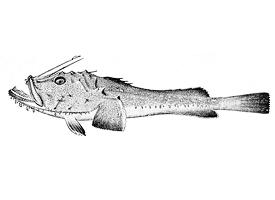
Váhy a míry
| Délka | od 20 do 100 cm |
|---|---|
| Hmotnost | 40 kg |
Popis zvířete
The Anglerfish, scientifically known as Lophius piscatorius, is a distinctive and fascinating marine creature that resides in the depths of the Atlantic Ocean and the Mediterranean Sea. This species is part of the Lophiidae family, known for its unique appearance and predatory tactics. The anglerfish is a master of disguise and an adept hunter, employing remarkable adaptations that have intrigued scientists and marine enthusiasts alike.Physical Description:
The Anglerfish possesses a large, flattened head that makes up the bulk of its body, with a wide mouth filled with sharp, translucent teeth that are angled inward to trap prey effectively. Its body color ranges from dark brown to a muddy gray, providing excellent camouflage against the rocky ocean floor. The anglerfish can grow up to 2 meters in length, although females are typically larger than males.
One of the most striking features of the Anglerfish is the modified spine on its head, known as the illicium or "fishing rod," which ends in a fleshy, bioluminescent lure called the esca. This lure is used to attract prey in the dark ocean depths where sunlight does not penetrate. The esca can emit light due to the presence of symbiotic bacteria, which is a rare example of mutualism in the deep sea.
Habitat and Distribution:
Lophius piscatorius is found in the northeastern Atlantic Ocean, from the Barents Sea to the Strait of Gibraltar, and in the Mediterranean Sea. It prefers muddy or sandy seabeds where it can easily camouflage itself, lying in wait for unsuspecting prey. This species typically resides at depths ranging from 20 to 1000 meters, although it is most commonly found between 200 and 500 meters.
Diet and Hunting Behavior:
The Anglerfish is an opportunistic predator that feeds on a variety of prey, including fish, cephalopods, and crustaceans. Its hunting strategy is one of patience and deception. The Anglerfish buries itself in the sediment, exposing only its lure. When a potential meal approaches, attracted by the glowing esca, the Anglerfish snaps its jaws shut in a fraction of a second, engulfing the prey whole.
Reproduction:
The reproductive process of the Anglerfish is as peculiar as its appearance. Females release pheromones to attract males, which are significantly smaller. Once a male finds a female, he latches onto her with his teeth, eventually fusing to her body. Over time, the male becomes a parasitic appendage, relying on the female for nutrients while providing sperm in return. This bizarre reproductive strategy ensures that when the female is ready to spawn, she has a mate immediately available.
Conservation Status:
The Anglerfish is not currently listed as endangered, but like many deep-sea species, it faces threats from overfishing and habitat destruction. Its unique biology and role in the marine ecosystem highlight the importance of conserving deep-sea habitats and the species that inhabit them.
In conclusion, the Anglerfish (Lophius piscatorius) is a remarkable example of adaptation and survival in the harsh environment of the deep sea. Its unique features and behaviors continue to captivate and inspire curiosity, making it a subject of ongoing study and fascination in the marine world.
Nové fotografie zvířat
Top 10 zvířat
- Chinese water dragon (Physignathus cocincinus)
- Galápagos tortoise (Geochelone nigra complex)
- Dolphin gull (Leucophaeus scoresbii)
- Japanese macaque (Macaca fuscata)
- Colombian red howler (Alouatta seniculus)
- Sea urchins (Echinoidea)
- Moustached guenon (Cercopithecus cephus)
- Diana monkey (Cercopithecus diana)
- Common reed warbler (Acrocephalus scirpaceus)
- Common house mosquito (Culex pipiens)